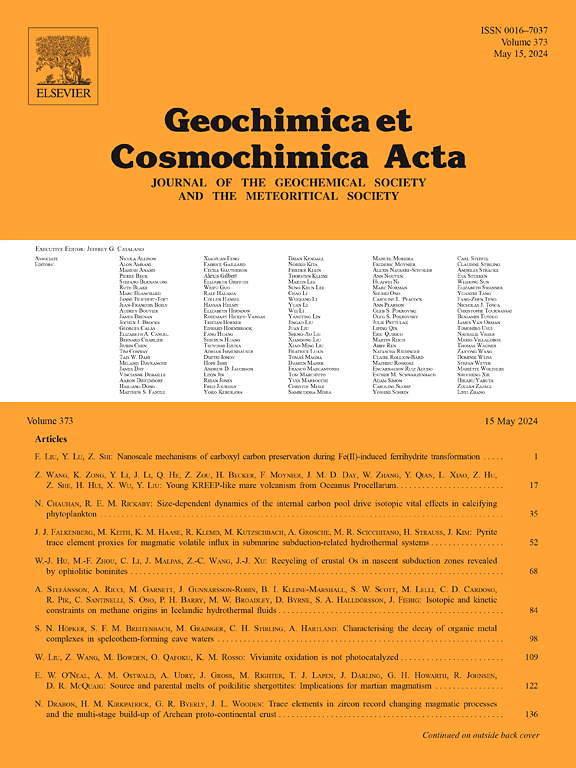Experimental constraints on stable potassium (K) isotope fractionation during phase separation in NaCl–KCl–H2O and KCl–H2O systems: implications for the K isotope composition of seafloor hydrothermal vent fluids
IF 5
1区 地球科学
Q1 GEOCHEMISTRY & GEOPHYSICS
引用次数: 0
Abstract
Phase separation is a ubiquitous process in marine hydrothermal systems, significantly influencing the chemical and isotopic composition of vent fluids. Understanding its effects on elemental partitioning and isotopic fractionation is essential for using vent fluid chemistry as an accurate predictor of the chemical and physical conditions at depth in the oceanic crust. Here, we report the first laboratory experimental study investigating stable potassium isotope (41K/39K) fractionation during phase separation of alkali (Na, K) chloride fluids under temperature and pressure conditions relevant to natural hydrothermal systems. Two distinct fluid compositions were tested in our experiments at 400 °C, including a mixed NaCl–KCl solution with a starting Na/K molar ratio of 10, and a pure KCl solution. This compositional difference allows for evaluating the role of Na on K isotope fractionation between coexisting vapor and liquid phases. For the NaCl–KCl–H2O system, all experiments showed preferential enrichment of light K isotopes in the vapor phase during phase separation, yielding an average K isotope fractionation factor of −0.12 ‰ (±0.04 ‰, 1SD). In sharp contrast with the NaCl–KCl–H2O experiments, the Na-free KCl–H2O experiments revealed no measurable K isotope fractionation during phase separation. These results suggest that Na plays a critical role in modifying K bonding environments, likely through the formation of multi-cation polynuclear species in the concentrated liquid phase. The coexistence of the multi-cation polynuclear species in the liquid and compositionally simpler K free ions or KCl°(aq) ion pairs in the vapor may account for the observed K isotope fractionation in the NaCl–KCl–H2O system. The absence of Na in the KCl–H2O system prevents significant differences in K bonding environments between vapor and liquid phases, thereby precluding measurable K isotope fractionation. Using the K isotope fractionation factor quantified here, a Rayleigh fractionation model can successfully explain the previously unexplained low δ41K values (∼−0.8 ‰) reported for vapor-dominated fluids at Main Endeavour Field (NE Pacific Ocean). These results highlight the importance of considering phase separation alongside seawater interaction with the oceanic crust to fully understand K isotope variations in hydrothermal systems.
NaCl-KCl-H2O和KCl-H2O体系相分离过程中稳定钾同位素分馏的实验约束:对海底热液喷口流体K同位素组成的影响
相分离是海洋热液系统中普遍存在的过程,对喷口流体的化学和同位素组成有重要影响。了解其对元素分配和同位素分馏的影响,对于利用喷口流体化学准确预测海洋地壳深处的化学和物理条件至关重要。在此,我们报告了在与天然热液系统相关的温度和压力条件下,对碱(Na, K)氯流体相分离过程中稳定钾同位素(41K/39K)分馏的首次实验室实验研究。在400°C的实验中,我们测试了两种不同的流体组成,包括初始Na/K摩尔比为10的NaCl-KCl混合溶液和纯KCl溶液。这种成分差异允许评估Na在共存的汽相和液相之间对K同位素分馏的作用。对于NaCl-KCl-H2O体系,在相分离过程中,轻K同位素在气相优先富集,平均K同位素分馏因子为- 0.12‰(±0.04‰,1SD)。与NaCl-KCl-H2O实验形成鲜明对比的是,无na的KCl-H2O实验显示在相分离过程中没有可测量的K同位素分馏。这些结果表明,Na在改变K键环境中起着关键作用,可能是通过在浓液相中形成多阳离子多核物质。液体中多阳离子多核物质的共存以及蒸汽中组成较简单的游离K离子或KCl°(aq)离子对的共存可能解释了在NaCl-KCl-H2O体系中观察到的K同位素分馏现象。由于KCl-H2O体系中Na的缺失,使得水蒸气和液相之间的K键环境不存在显著差异,因此无法测量K同位素分馏。利用本文量化的K同位素分馏因子,Rayleigh分馏模型可以成功解释此前未解释的主要Endeavour油田(东北太平洋)蒸汽主导流体的低δ41K值(~−0.8‰)。这些结果强调了考虑相分离以及海水与海洋地壳相互作用对于充分理解热液系统中K同位素变化的重要性。
本文章由计算机程序翻译,如有差异,请以英文原文为准。
求助全文
约1分钟内获得全文
求助全文
来源期刊

Geochimica et Cosmochimica Acta
地学-地球化学与地球物理
CiteScore
9.60
自引率
14.00%
发文量
437
审稿时长
6 months
期刊介绍:
Geochimica et Cosmochimica Acta publishes research papers in a wide range of subjects in terrestrial geochemistry, meteoritics, and planetary geochemistry. The scope of the journal includes:
1). Physical chemistry of gases, aqueous solutions, glasses, and crystalline solids
2). Igneous and metamorphic petrology
3). Chemical processes in the atmosphere, hydrosphere, biosphere, and lithosphere of the Earth
4). Organic geochemistry
5). Isotope geochemistry
6). Meteoritics and meteorite impacts
7). Lunar science; and
8). Planetary geochemistry.
 求助内容:
求助内容: 应助结果提醒方式:
应助结果提醒方式:


